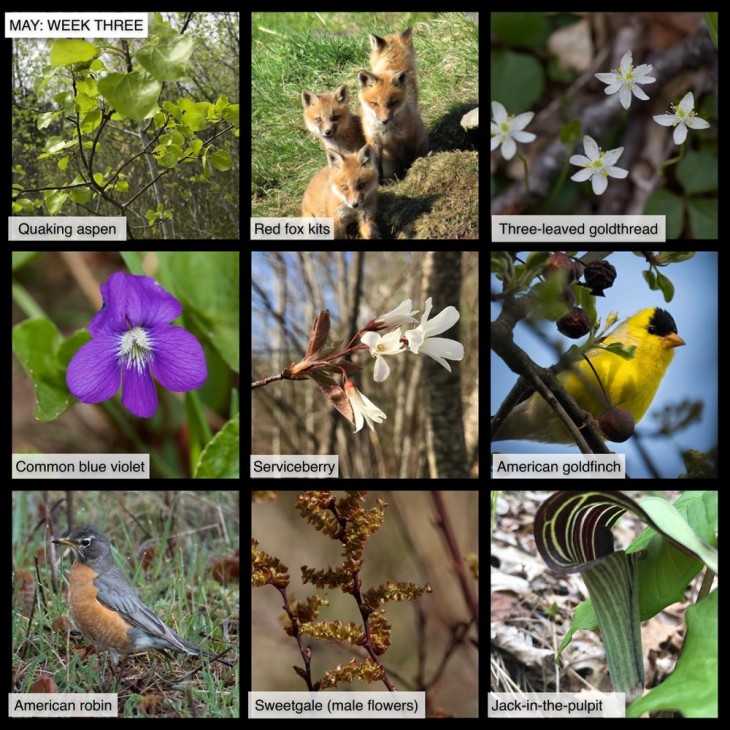This week in the woods, we’ve been noticing the new, bright green leaves of young quaking aspen. This is an early successional species, meaning that it quickly colonizes cleared areas and other disturbed sites. Fun fact: when you see a thick stand, you’re probably looking at clones connected by an extensive root system. Individual trees are relatively short-lived, but a connected group can live indefinitely, and according to the National Wildlife Federation, “a grove of quaking aspens in Utah is the largest known living thing on Earth. Nearly 50,000 stems protrude from a single root system. The entire organism covers over 100 acres and weighs 6,000 tons.” The tree is also noteworthy for its high wildlife value. See for example this link to the Ruffed Grouse Society, describing the significance of quaking aspen for grouse.
We cheated on our “15 miles from the office rule” to include this photo of red fox kits, taken by assistant editor Meghan McCarthy McPhaul in Sugar Hill. We’ve also heard reports of baby foxes appearing out of their dens in the Upper Valley. Here are some additional photos and notes about fox family life, and a related Outside Story article.
The wildflowers keep coming! Three-leaved goldthread has just started to bloom. This dainty evergreen grows at the edge of wetlands and in damp forest soil. Its name refers to the orange color of its rhizomes. Goldthread has a long pedigree of traditional uses, in part because of its high concentration of the (potentially toxic, please note!) alkaloid berberine. Here’s a string of links about the plant from the Native American Ethnobotany Database.
As noted last week, violets are popping up everywhere, in woods, meadows and yards. We’ve previously shared an image of long-spurred violets, but for color extravagance, nothing beats the common blue violet. Unlike long-spurred violets, which mostly stick to deep woods in small patches, and we don’t recommend picking, common blues grow in abundance in many places, including meadows and maybe your lawn. A fun activity for kids: pick some of these edible flowers to decorate a cake, or try some of its leaves in a salad. Here’s a just-published article about violets by Laurie D. Morrissey, including some fun historical notes.
Serviceberry is in full bloom now. Look for this small tree along woods edges, including growing along many roads. Also known as shadbush, shadblow and a number of other names, it’s a boon to pollinators and other wildlife. Here’s an overview of the species by Jim Frohn from the UNH Cooperative Extension site.
It’s not your imagination; male American goldfinches really are more brightly feathered this time of year. As Joe Rankin explains in this article, when male birds invest in mating plumage bling, they’re signaling fitness as mates. “Females are choosing males that are gaudy because you can only be gaudy if you can find enough nutrition to afford to make those fancy clothes.” There’s a lot that’s surprising about goldfinches, from their devotion to vegetarianism, to their lack of territoriality. See this Outside Story article by Barb Mackey for more about the birds.
Another common bird worthy of a closer look: the American robin. How many can you find in one walk? Can you find a nest? As Brian Pfeiffer notes, these ubiquitous birds owe some of their success to their flexible diets; “a study of stomach contents from 1,169 robins featured fruits of 50 genera and invertebrates from more than 100 families.” Here’s an Outside Story article describing their nesting habits, and how climate change has likely extended their winter range.
Down in the wetlands, sweetgale is in bloom. Male flowers - tiny and yellow – are tucked between much more noticeable bracts. Female flowers take the form of red tufts. Here’s a profile (including a photo of the female flowers) from Adirondacks Forever Wild. Not mentioned on that site: the plant’s beer brewing connection. Here’s a note from Wikipedia.
We also noticed Jack-in-the-pulpit for the first time this week. Here’s (yet another) Outside Story article, describing this distinctive wildflower, which can switch genders year-to-year.
In this difficult period, many of us find joy in observing local nature, and many families are seeking outdoor enrichment opportunities for children. Here are nine photographs taken this past week in forests within 15 miles of the Northern Woodlands office in Lyme, New Hampshire. We hope you enjoy using this grid as a prompt for your own explorations, or as the basis for a game of family forest tic-tac-toe.
What are you seeing in the woods this week? Share your images with us on Facebook, or submit a special photo for possible inclusion in our monthly online Reader Photo Gallery.



Discussion *